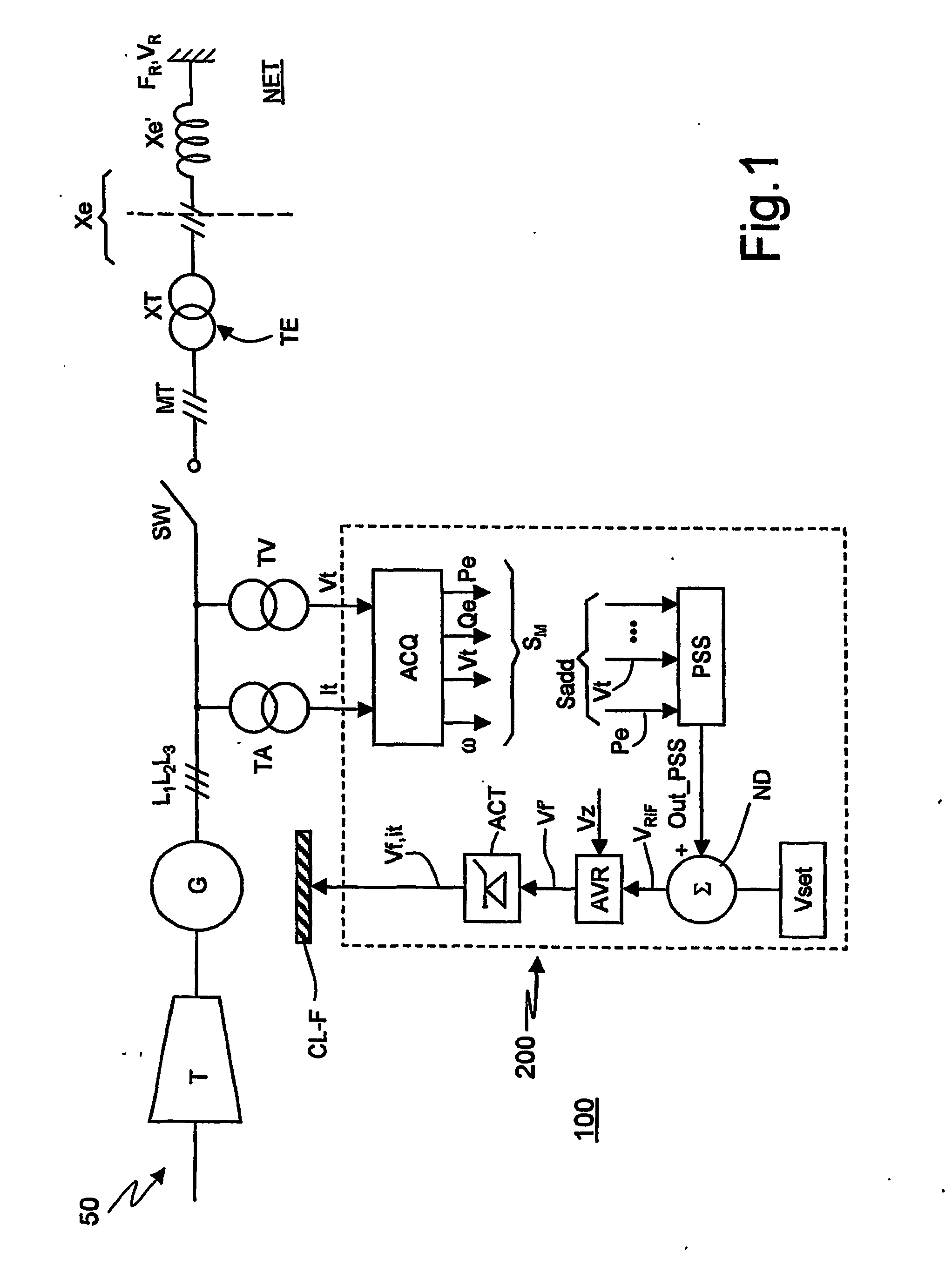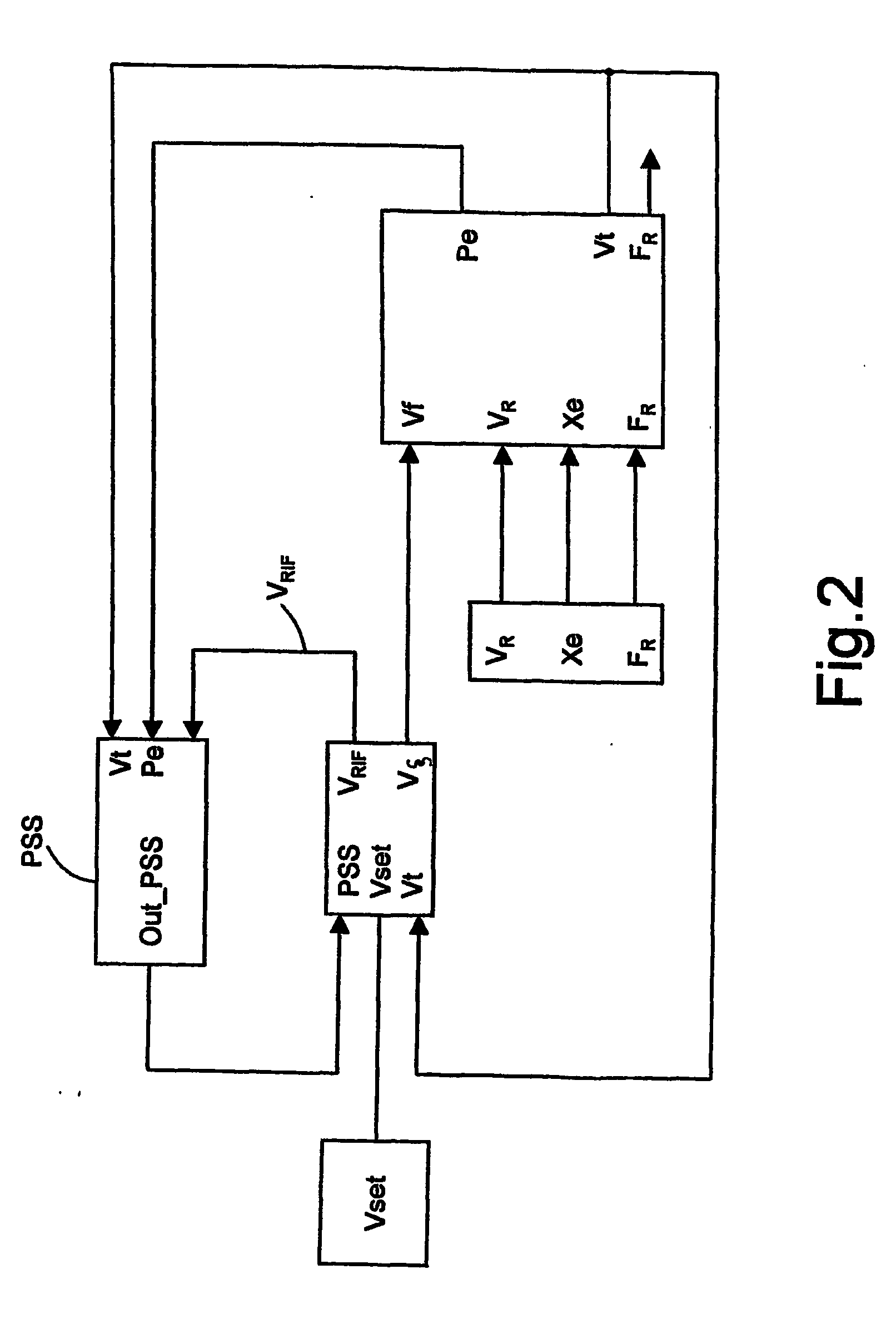Compensator device for stabilising the power of alternators in electrical power generating plants
- Summary
- Abstract
- Description
- Claims
- Application Information
AI Technical Summary
Problems solved by technology
Method used
Image
Examples
first embodiment
[0097] According to this first embodiment, a second order deriving filter is used.
[0098] The stabiliser device PSS is provided with a first 1 and a second 2 input terminal for its main input signal which, according to said example, are active electrical power PE and machine voltage vt.
[0099] The stabiliser device PSS implements the following equations: σ^(t)=(ⅆⅆt+λ)·ξ^.(t)Out_PSS=H·sign(ξ)·f(σ^)·sign(σ^)Equations 22
[0100] The equations 22 are similar to the equations 15 and to the first of the equations 7. In particular, the symbol “ˆ” indicates that the corresponding quantities are obtained by estimation. Moreover, it should be recalled that the estimated quantity ξ is expressed in accordance with the equation 12.
[0101] In the second of the equations 22, note that the gain H has the sign of ξ to guarantee the sliding modes condition and f(σ) is any suitable function.
[0102] For example, for the sliding modes approximation the function f(σ) is:
f=1, |σ| / Φ>1; f=|σ|, |σ| / Φ&...
second embodiment
[0126]FIG. 4 shows a PSS compensator in accordance with the present invention. According to the embodiment of FIG. 4, the processing of the measurement signals for estimating the sliding surface σ(t) is performed not with a second order filter but with a linear or non linear observer 4′. Moreover, it should be noted that the observer 4′ can be obtained with a sliding modes technique (sliding observers).
[0127] In the diagram of FIG. 4, the same numerical references of FIG. 3 are used to designate identical or similar components.
[0128] The observer 4′ is connected to the output of the divider block 3 to receive the signal PE / vt and to a third input terminal 2′ to receive at least another signal.
[0129] For example, the third terminal is provided with the voltage reference electrical signal vRIF which is also sent to the voltage regulator AVR shown in FIG. 1. Note that the fact that to the compensator PSS is sent the reference signal of vRIF is also indicated in the diagram of FIG. 2....
third embodiment
[0132]FIG. 5 shows a compensator PSS according to the invention, in which control is based on the measurement of rotor velocity ω. This embodiment is particularly advantageous because the measurement of rotor velocity ω is commonly available in the velocity regulators of turbo-machines and hence can be easily acquired in rapid and precise fashion.
[0133] In this case, one starts from the equations in δ: ⅆδⅆt=ω-ωR=δ.(t)ⅆδ.ⅆt=Cm-CeJ con Ce=vRxe·(ψq·cos δ+ψd·sin δ)ⅆ2δ.ⅆt2=C.m-vRxe·[(ψd·cos δ-ψq·sin δ)·δ.+ⅆψdⅆt·sin δ+ⅆψqⅆt·cos δ]JEquation 26
[0134] where, as always, δ is the angle between axis q and the network voltage vector, having amplitude VR, ω is the angular velocity of the reference system integral with axis q (i.e. rotor velocity), ωR is electrical network frequency, and lastly Cm and Ce designate the motive torque and the electrical torque, respectively. Moreover, ψd and ψq are the direct axis flow, and the quadrature axis flow, respectively, and they are...
PUM
 Login to View More
Login to View More Abstract
Description
Claims
Application Information
 Login to View More
Login to View More - R&D
- Intellectual Property
- Life Sciences
- Materials
- Tech Scout
- Unparalleled Data Quality
- Higher Quality Content
- 60% Fewer Hallucinations
Browse by: Latest US Patents, China's latest patents, Technical Efficacy Thesaurus, Application Domain, Technology Topic, Popular Technical Reports.
© 2025 PatSnap. All rights reserved.Legal|Privacy policy|Modern Slavery Act Transparency Statement|Sitemap|About US| Contact US: help@patsnap.com



